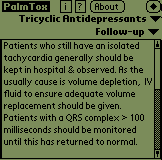 |
|
|
|
PalmTox is a TealInfo folio put out as a subset of MedTox. (Take a look at www.Hypertox.com for more information.) It would probably be most useful to ED Nurses, Physicians, and EMS workers. PalmTox is quite simple to use: Look up the toxin class on a pull-down menu (acetaminophen is in a class of its own, but amitriptyline is in with the other tricyclic antidepressants), and then have instant access (again, by pull down menu) to an overview, mechanism of toxicity, kinetics, clinical effects, investigations (diagnostic tools), differential diagnosis, treatment, and follow-up recommendations. The list of toxins is by no means comprehensive, and all the recommendations assume that basic life support is underway. That said, PalmTox covers all the toxins I ran into while I worked in the ED, and has several treatment recommendations that have changed since my ED days, indicating that this material is updated. One nice feature is that PalmTox indicates whether or not gastric lavage is useful or even contraindicated, along with the rationale. (I remember working with old school ED docs who lavaged basically any oral exposure to any toxin. This has since been shown to unnecessary much of the time and even contraindicated in many cases.) PalmTox also addresses absorbents (such as charcoal or fullers earth), specific antidotes (the classic example is N-acetylcysteine (NAC or Mucomyst) in acetaminophen poisoning), as well as techniques to improve excretion of toxins (such as acidification or alkalization of the urine), up to and including dialysis. Included with the PalmTox folio is a much smaller folio that serves as the nomogram for calculating toxicity risk in acetaminophen poisoning. It would be nice if the nomogram could also calculate the dosing schedule for Mucomyst, but that's just getting picky. PalmTox was programmed in Australia, and does, therefore have some differences in drug names and availability (there are some drugs available in Oz that are not available in the US, (and vice-versa I'm sure). There are also a few differences in drug names between the US and Oz (acetaminophen is paracetamol, and lidocaine is lignocaine for example). Generally this is not a problem, and the acetaminophen section is labeled both ways, but it does take a little getting used to, and there are a few odd spellings. (It is interesting to note that Mucomyst can be given IV in Oz). The file is large (410K) which could be a problem for people using 2Mb machines (Palm III's, V's and VII's, M100's, and Visor Solos), and might be a problem for higher memory machines if, like me, you tend to collect stuff. People with Visors or TRG Pros might want to keep the folio on a storage card to be pulled out when you need it, although this tends to slow things down a bit. Speaking of slow, there is also a pause of about six seconds waiting for the program to run during which my Visor Deluxe's screen is completely blank (which I find slightly disconcerting when considering that I'm used to sub-second delays). I think a faster machine (a Visor Platinum or Prism for example) would probably cut that pause way down. Still, Six seconds is much less than it takes for Micromedex to load off my hospital's intranet, which what I used to use to look up toxicology info when I worked ED, so I can't complain. Overall, I would definitely recommend this product to critical care nurses, (ER or ICU), ER and ICU MDs, or even medics in the field (although medics are often limited to their protocols, so it may only be of academic interest.) I'd give it 90 out of 100 (great story, nice beat, but drags a little at the beginning.) Keith Anderson can be reached via email
|
||||||||

